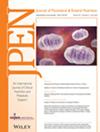Association between epigenetic clock acceleration and malnutrition among adults in the United States: A cross-sectional study
Abstract
Background
We investigated relationships between nutrition assessment tools (Controlling Nutritional Status [CONUT], Geriatric Nutritional Risk Index [GNRI], and Naples Prognostic Score [NPS]) and epigenetic clocks, evaluating malnutrition's impact on biological aging.
Methods
Using National Health and Nutrition Examination Survey database (1999–2002), 2532 participants aged ≥50 years were assessed with three nutrition tools and analyzed against 12 epigenetic clocks using multiple linear regression models adjusted for confounding factors.
Results
Malnutrition prevalence rates were 13.5% (CONUT), 4.2% (GNRI), and 46.8% (NPS). Compared with no-risk groups, moderate-to-severe malnutrition showed significant epigenetic age acceleration, particularly in NPS assessment. GrimAge2Mort demonstrated up to 4.19 years acceleration (in NPS model 3, P < 0.01), DunedinPoAm showed significant increase (in NPS model 3, β = 0.083, P < 0.01), and YangCell significantly decreased (in NPS model 3, β = −0.019, P < 0.01). These associations remained significant after adjusting for confounding factors. A clear dose-response relationship existed between malnutrition and epigenetic age acceleration.
Conclusion
This study provides first systematic evidence of significant associations between malnutrition and epigenetic age acceleration, particularly in moderate-to-severe malnutrition, leading to substantial biological aging acceleration. GrimAge2Mort, DunedinPoAm, and YangCell emerged as stable indicators for assessing nutrition-related biological aging. These findings provide new insights into malnutrition's impact on aging and offer important references for clinical nutrition intervention strategies.


 求助内容:
求助内容: 应助结果提醒方式:
应助结果提醒方式:


